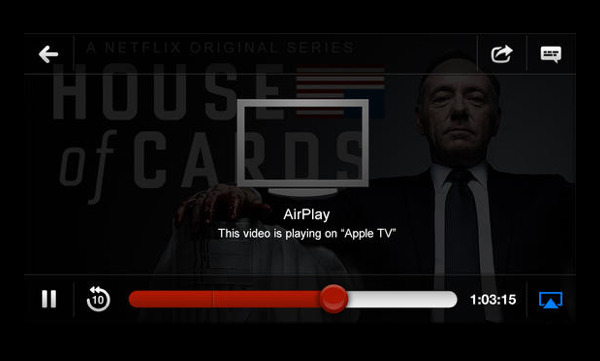Netflix disabled AirPlay because it isn't being told what device is getting the stream
Netflix has elaborated on the "technical reasons" why it has disabled AirPlay, and claims that since it can't tell what device the stream is being sent to because of changes in the protocol, it won't allow the feature.

Netflix debuted AirPlay support in 2013.
In a statement to AppleInsider and other venues, Netflix is blaming the removal of the feature on Apple, and it allowing AirPlay on third-party televisions.
Netflix has made it clear that apps on iOS and Apple TV are unaffected for native playback on the device that they are installed on. However, going forward, users won't be able to use AirPlay to stream the content to another device.
The change in app policy was spotted on Friday in an update to the official Netflix Help Center webpage, which now instructs iOS device users to connect to a TV using Chromecast functionality in the television, Netflix 2nd Screen, or a physical cable. Customers attempting to stream video content to an Apple TV or AirPlay-compatible device are now met with an error message.
At CES 2019, Samsung, Sony and Vizio each revealed upcoming TV hardware support for Apple's streaming protocol in separate announcements. Korean tech giant LG followed suit in March.
Netflix's AirPlay withdrawal hit just two days after Vizio launched a beta version of its SmartCast 3 software with support for both AirPlay 2 and HomeKit.

Netflix debuted AirPlay support in 2013.
In a statement to AppleInsider and other venues, Netflix is blaming the removal of the feature on Apple, and it allowing AirPlay on third-party televisions.
At present, it isn't clear what Netflix gains by knowing what television is being used, other than data harvesting. It also isn't clear what the company being unable to "certify these experiences" means, from a technical standpoint.We want to make sure our members have a great Netflix experience on any device they use. With AirPlay support rolling out to third-party devices, there isn't a way for us to distinguish between devices -- what is an Apple TV versus what isn't -- or certify these experiences.
Therefore, we have decided to discontinue Netflix AirPlay support to ensure our standard of quality for viewing is being met. Members can continue to access Netflix on the built-in app across Apple TV and other devices.
Netflix has made it clear that apps on iOS and Apple TV are unaffected for native playback on the device that they are installed on. However, going forward, users won't be able to use AirPlay to stream the content to another device.
The change in app policy was spotted on Friday in an update to the official Netflix Help Center webpage, which now instructs iOS device users to connect to a TV using Chromecast functionality in the television, Netflix 2nd Screen, or a physical cable. Customers attempting to stream video content to an Apple TV or AirPlay-compatible device are now met with an error message.
At CES 2019, Samsung, Sony and Vizio each revealed upcoming TV hardware support for Apple's streaming protocol in separate announcements. Korean tech giant LG followed suit in March.
Netflix's AirPlay withdrawal hit just two days after Vizio launched a beta version of its SmartCast 3 software with support for both AirPlay 2 and HomeKit.

Comments
Moreover, there is no need to distinguish the type of device for this purpose. The only thing that is relevant is the number of devices.
Wrong. In AirPlay Video, the target TV/Apple TV downloads the video. The mobile device only controls the playback. What you mentioned is AirPlay Screen, which mirrors the phone screen to the TV say, for presentation. Different tech.
I don’t believe Netflix when they say they can’t tell the requesting device.
Mobile phone UI is a lot more advanced than TV device UI. So AirPlay makes sense.
This will be resolved.
Really. You know this, how?
Otherwise, I'm with you on hardwiring, etc.
My experiences with Netflix have become increasingly negative. One way to protect one’s privacy is to use a VPN. When I use a VPN Netflix disables my ability to watch its content on my computer or tablet, even if the VPN is located in the USA and I have a USA based Netflix account. Netflix claims this is due to licensing restrictions on its content, but it is really to force users to disable the VPN so that Netflix can track what users watch. (Licensing restrictions should not be an issue on shows that Netflix produces.)
This is all about collecting subscriber data to maximize profits. I think Netflix is going to be the next Facebook fiasco once users realize how their personal data is used.
Because the Airplay source iPhone can be disconnected from the network and switched off, and the video continues to play.
Since the stream is handed off to the device being viewed, Netflix knows exactly what device is streaming their content and exactly what quality to send to it. When I first heard about this, I thought it was a bug in their effort to restrict AirPlay on a Mobile only plan, which has lower bandwidth, and streaming to a TV would increase. But this latest excuse pulls the curtain back, since AirPlay works no differently than chromecast, and Netflix hasn’t restricted that.